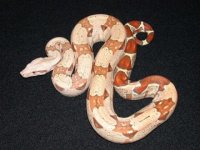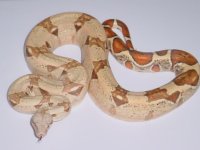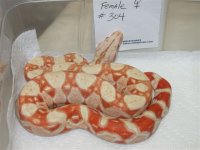Posted by: Hurley at Wed Nov 24 08:38:32 2004 [ Report Abuse ] [ Email Message ]
Of course that snake has "black" in it, just not what you are used to seeing. There is melanin there, just in a reduced amount. Biggest tipoff if that its pupil is black. Black pupils are caused by the melanin lining of the retina at the back of the eye that functions to absorb light to keep light from reflecting and bouncing back forward resulting in double signaling. A non-melanin producing snake will not have black pupils, period. The snake's background also clearly shows that there are melanins there. Melanins give you your browns and blacks, that snake has less pigment, so it's lighter, yes, but there is an amount of melanin there.
T+ albino is a term that has been grossly stretched and skewed to mean so many things that no one can follow it anymore. People seem to think that T+ albino means that it's "reduced in pigment, but not visually an amel". This seems a bit strange to me. By that definition, I'm a T-positive albino, my hair is lighter than black and my eyes are blue showing reduced melanin in the iris. By that definition, hypos at "T+albinos" as well.
If you are Tyrosinase positive, you have the ability to follow through on one of the many steps in the melanin-producing pathway. You can test it with the DOPA test, taking a piece of an albino's skin, adding DOPA (the substrate that Tyrosinase acts on to lead to melanin), and watching for melanin to develop, i.e. looking for black to come in. If you have the enzyme tyrosinase (which almost all morphs do), then you are T+ .
Now, T + albino is a term that designates that the snake is albino, but the mechanism for the albinism is NOT lack of tyrosinase. It could be any other enzyme along the pathway, just not tyrosinase. Whatever the mechanism, the snake should still be albino.
I guess it depends on how pure you are in your definitions. What does albino truely mean? This term as well has been stretched so far that it has lost all meaning except a reduction or loss of some pigment. Honestly, I wish the whole mystical "T + Albino" term would go away. There is not just one "T + Albino", it covers almost as many mutations as "Albino" save 1, the T-Negative Amelanistic. Hypos won't be T- because they do produce melanin, which can't be done without tyrosinase to my knowledge. In the herp community, Albino covers anything that is slightly hypomelanistic through amelanism as long as a DOPA test shows tyrosinase exists.... which how many of the "T+ Albinos" at shows have ever been tested to see that they are T+? (Not that it's really necessary since most people call light hypos "T+ Albinos" and I can about guarantee there is tyrosinase there since they produce some melanin.)
So, I guess in a way, I agree with you Terry. That snake is almost positively T+...there is melanin there. I personally think the term "albino" is a mistake, but I don't use the term anyway since its definition is so stretched that it is practically a non-definer. If you are comfortable calling a specimen with reduction but not absence of a specific pigment "albino", then you are right on, just know that you've reduced the word to practically no meaning covering a huge range of pigmentation. The only thing it excludes is a totally normal melanin producing animal. Everything from slightly reduced to amel with tyrosinase is then encompassed in the term T+ Albino.
People like the term "T+ Albino", it sounds scientific and cool and it sells snakes since everyone strives for the magical T+ Albino. It doesn't really matter to me and I write this just to get people thinking about what the term really means and what it represents, not in a rant tone of voice. That snake is a hypomelanistic by definition of the word. Hypo means reduced (sure, greatly reduced I agree, but not absent) and mela- obviously means melanin, -ism = a condition of. Hypomelanism - a condition of having reduced melanin.
Is it a Tyrosinase Positive animal? Almost certainly. Is it a Tyrosinase Positive Albino? ...depends on how wide you make your definition of albino. I personally remove the need for interpretation and just dump the term altogether. The only place it has value in my life is in differentiating amelanistics by whether or not the enzyme is present.
Great animal, no matter what you call it. I look forward to having some some day.
As always, JMO.
-----
~~~Hurley






